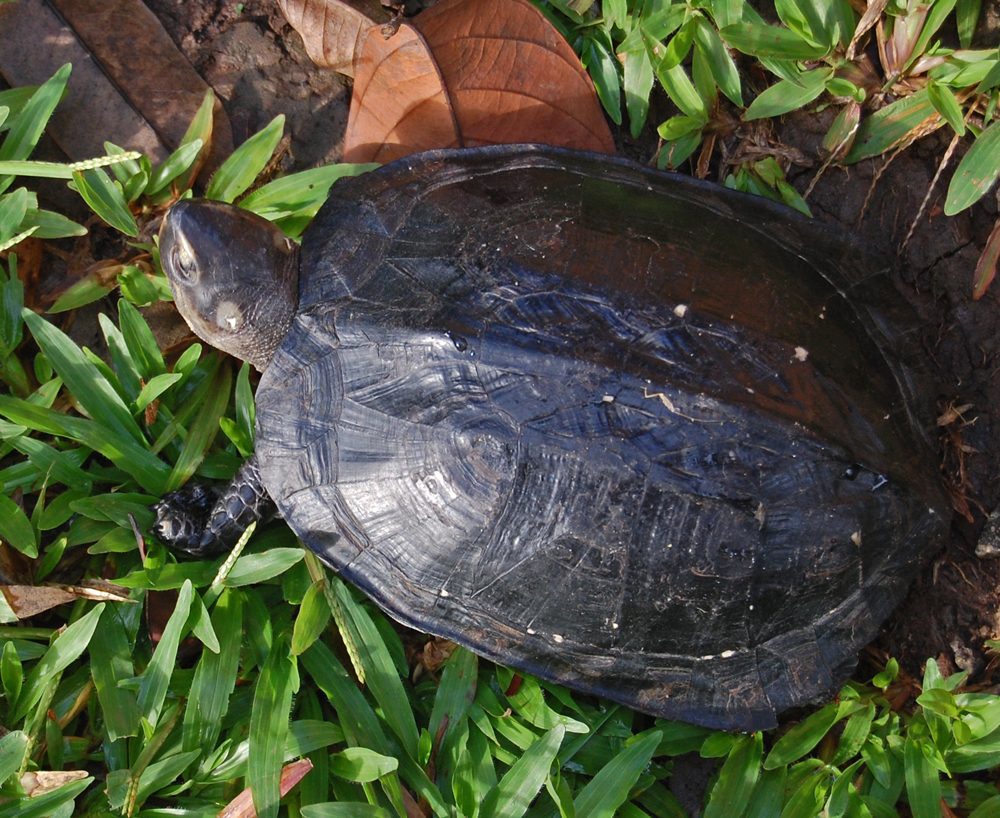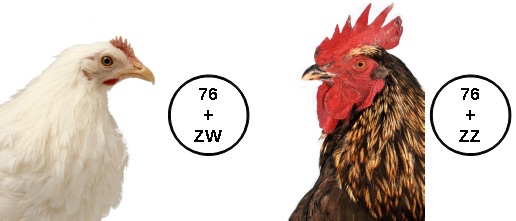|
Geoemydidae
The Geoemydidae (formerly known as Bataguridae) are one of the largest and most diverse families in the order Testudines (turtles), with about 70 species. The family includes the Eurasian pond and river turtles and Neotropical wood turtles. Members of this family are commonly called Leaf turtle. Characteristics Geoemydidae are turtles of various sizes (from about in length) with often a high degree of sexual dimorphism. They usually have webbed toes, and their pelvic girdles articulate with their plastrons flexibly. Their necks are drawn back vertically. Their carapaces have 24 marginal scutes. The plastron is composed of 12 scutes and has no mesoplastron; the pectoral and abdominal scutes contact the marginal scutes. Some other features include a single articulation between the fifth and sixth cervical vertebrae, the lack of a hyomandibular branch of the facial nerve, and an epipterygoid bone in the skull. Ecology Geoemydidae live in tropics and subtropics of Asia, Europe ... [...More Info...] [...Related Items...] OR: [Wikipedia] [Google] [Baidu] |
Emydidae
Emydidae (Latin ''emys'' (freshwater tortoise) + Ancient Greek εἶδος (''eîdos'', “appearance, resemblance”)) is a family of testudines (turtles) that includes close to 50 species in 10 genera. Members of this family are commonly called terrapins, pond turtles, or marsh turtles. Several species of Asian box turtles were formerly classified in the family; however, revised taxonomy has separated them to a different family (Geoemydidae). As currently defined, the Emydidae are entirely a Western Hemisphere family, with the exception of two species of pond turtle. Description The upper shell (carapace) of most emydids is the shape of a low arch, although in some species, it is domed. The upper shell may have one or two ridges that run from front to the back of the animal (a projection commonly called a "keel"), or such a feature may be absent. A prominent bridge often connects the top shell to the bottom shell ( plastron). Emydids have large bottom shells, and some memb ... [...More Info...] [...Related Items...] OR: [Wikipedia] [Google] [Baidu] |
Brown Roofed Turtle
The brown roofed turtle (''Pangshura smithii'') is a species of turtle in the family Geoemydidae. The species is endemic to South Asia. Two subspecies are recognized. Etymology The specific name, ''smithii'', is in honor of Scottish zoologist Andrew Smith. Description The carapace of ''P. smithii'' is much depressed and feebly keeled. The nuchal shield is small, trapezoidal, and broadest posteriorly. The first vertebral has sinuous lateral borders and is usually a little narrower in front than behind. The second vertebral is shortest, broader than long, and usually with straight or slightly convex posterior border. The third vertebral is considerably longer than broad, subquadrangular, and its posterior border is straight or slightly convex. The fourth vertebral is longest, tapering anteriorly and forming a narrow suture with the third. The fifth vertebral is much broader than the others. The large plastron is feebly angulated laterally. The front lobe is rounded. The hind lo ... [...More Info...] [...Related Items...] OR: [Wikipedia] [Google] [Baidu] |
Black Marsh Turtle
''Siebenrockiella crassicollis'' (commonly known as black marsh turtle, smiling terrapin, and Siamese temple turtle, among others) is a freshwater turtle endemic to Southeast Asia. It is one of two species classified under the genus '' Siebenrockiella'' in the family Geoemydidae. Black marsh turtles are small to medium-sized turtles that are almost completely black except for white to yellow markings on the head. They are largely aquatic and prefer slow-moving or still bodies of water with heavy vegetation. Black marsh turtles are also commonly kept as pets and as sacred animals in Southeast Asian Buddhist temples. They are classified as endangered by the IUCN, being one of the several Southeast Asian turtle species heavily exploited for the international wildlife trade, particularly for food and traditional medicine in the Chinese markets. Taxonomy and nomenclature Formerly under the genus ''Emys'', black marsh turtles are now classified under ''Siebenrockiella''. They were fi ... [...More Info...] [...Related Items...] OR: [Wikipedia] [Google] [Baidu] |
Rhinoclemmys
''Rhinoclemmys'' is a genus of turtles in the family Geoemydidae (formerly Bataguridae), the only genus in the subfamily Rhinoclemmydinae. Member species of the genus are commonly known as the Neotropical wood turtles and are the only geoemydids known from the Americas. As such, they have adapted to a wide range of habitats, which is reflected in the species' common names. Species The genus ''Rhinoclemmys'' contains the following extant and fossil species which are recognized as being valid: * ''R. annulata'' – brown wood turtle * ''R. areolata'' – furrowed wood turtle * ''R. diademata'' – Maracaibo wood turtle * ''R. funerea'' – black river turtle * ''R. melanosterna'' – Colombian wood turtle * ''R. nasuta'' – large-nosed wood turtle * ''R. pulcherrima'' – painted wood turtle * ''R. punctularia'' – spot-legged wood turtle * ''R. rubida'' – Mexican spotted wood turtle * †'' R. panamaensis'' - Hemingfordian - Cucaracha Formation, Panama ''Nota bene ... [...More Info...] [...Related Items...] OR: [Wikipedia] [Google] [Baidu] |
Rhinoclemmys Pulcherrima
The ornate or painted wood turtle The Reptile Database (''Rhinoclemmys pulcherrima'') is one of nine of the '''' of the |
Ornate Wood Turtle
The ornate or painted wood turtle The Reptile Database (''Rhinoclemmys pulcherrima'') is one of nine of the '''' of the |
Testudines
Turtles are an order (biology), order of reptiles known as Testudines, characterized by a special turtle shell, shell developed mainly from their ribs. Modern turtles are divided into two major groups, the Pleurodira (side necked turtles) and Cryptodira (hidden necked turtles), which differ in the way the head retracts. There are 360 living and recently extinct species of turtles, including land-dwelling tortoises and freshwater terrapins. They are found on most continents, some islands and, in the case of sea turtles, much of the ocean. Like other Amniote, amniotes (reptiles, birds, and mammals) they breathe air and do not lay eggs underwater, although many species live in or around water. Turtle shells are made mostly of bone; the upper part is the domed Turtle shell#Carapace, carapace, while the underside is the flatter plastron or belly-plate. Its outer surface is covered in scale (anatomy), scales made of keratin, the material of hair, horns, and claws. The carapace bon ... [...More Info...] [...Related Items...] OR: [Wikipedia] [Google] [Baidu] |
Neotropical
The Neotropical realm is one of the eight biogeographic realms constituting Earth's land surface. Physically, it includes the tropical terrestrial ecoregions of the Americas and the entire South American temperate zone. Definition In biogeography, the Neotropic or Neotropical realm is one of the eight terrestrial realms. This realm includes South America, Central America, the Caribbean islands, and southern North America. In Mexico, the Yucatán Peninsula and southern lowlands, and most of the east and west coastlines, including the southern tip of the Baja California Peninsula are Neotropical. In the United States southern Florida and coastal Central Florida are considered Neotropical. The realm also includes temperate southern South America. In contrast, the Neotropical Floristic Kingdom excludes southernmost South America, which instead is placed in the Antarctic kingdom. The Neotropic is delimited by similarities in fauna or flora. Its fauna and flora are distinct ... [...More Info...] [...Related Items...] OR: [Wikipedia] [Google] [Baidu] |
Omnivore
An omnivore () is an animal that has the ability to eat and survive on both plant and animal matter. Obtaining energy and nutrients from plant and animal matter, omnivores digest carbohydrates, protein, fat, and fiber, and metabolize the nutrients and energy of the sources absorbed. Often, they have the ability to incorporate food sources such as algae, fungi, and bacteria into their diet. Omnivores come from diverse backgrounds that often independently evolved sophisticated consumption capabilities. For instance, dogs evolved from primarily carnivorous organisms ( Carnivora) while pigs evolved from primarily herbivorous organisms (Artiodactyla). Despite this, physical characteristics such as tooth morphology may be reliable indicators of diet in mammals, with such morphological adaptation having been observed in bears. The variety of different animals that are classified as omnivores can be placed into further sub-categories depending on their feeding behaviors. Frugivor ... [...More Info...] [...Related Items...] OR: [Wikipedia] [Google] [Baidu] |
Endangered Species
An endangered species is a species that is very likely to become extinct in the near future, either worldwide or in a particular political jurisdiction. Endangered species may be at risk due to factors such as habitat loss, poaching and invasive species. The International Union for Conservation of Nature (IUCN) Red List lists the global conservation status of many species, and various other agencies assess the status of species within particular areas. Many nations have laws that protect conservation-reliant species which, for example, forbid hunting, restrict land development, or create protected areas. Some endangered species are the target of extensive conservation efforts such as captive breeding and habitat restoration. Human activity is a significant cause in causing some species to become endangered. Conservation status The conservation status of a species indicates the likelihood that it will become extinct. Multiple factors are considered when assessing the ... [...More Info...] [...Related Items...] OR: [Wikipedia] [Google] [Baidu] |
ZW Sex-determination System
The ZW sex-determination system is a chromosomal system that determines the sex of offspring in birds, some fish and crustaceans such as the giant river prawn, some insects (including butterflies and moths), the schistosome family of flatworms, and some reptiles, e.g. majority of snakes, lacertid lizards and monitors including Komodo dragons. It is also used in some plants where it has probably evolved independently on several occasions. The letters Z and W are used to distinguish this system from the XY sex-determination system. In this system, females have a pair of dissimilar ZW chromosomes, and males have two similar ZZ chromosomes. In contrast to the XY sex-determination system and the X0 sex-determination system, where the sperm determines the sex, in the ZW system, the ovum determines the sex of the offspring. Males are the homogametic sex (ZZ), while females are the heterogametic sex (ZW). The Z chromosome is larger and has more genes, like the X chromosome in the XY sys ... [...More Info...] [...Related Items...] OR: [Wikipedia] [Google] [Baidu] |
Family (biology)
Family ( la, familia, plural ') is one of the eight major hierarchical taxonomic ranks in Linnaean taxonomy. It is classified between order and genus. A family may be divided into subfamilies, which are intermediate ranks between the ranks of family and genus. The official family names are Latin in origin; however, popular names are often used: for example, walnut trees and hickory trees belong to the family Juglandaceae, but that family is commonly referred to as the "walnut family". What belongs to a family—or if a described family should be recognized at all—are proposed and determined by practicing taxonomists. There are no hard rules for describing or recognizing a family, but in plants, they can be characterized on the basis of both vegetative and reproductive features of plant species. Taxonomists often take different positions about descriptions, and there may be no broad consensus across the scientific community for some time. The publishing of new data and opini ... [...More Info...] [...Related Items...] OR: [Wikipedia] [Google] [Baidu] |





